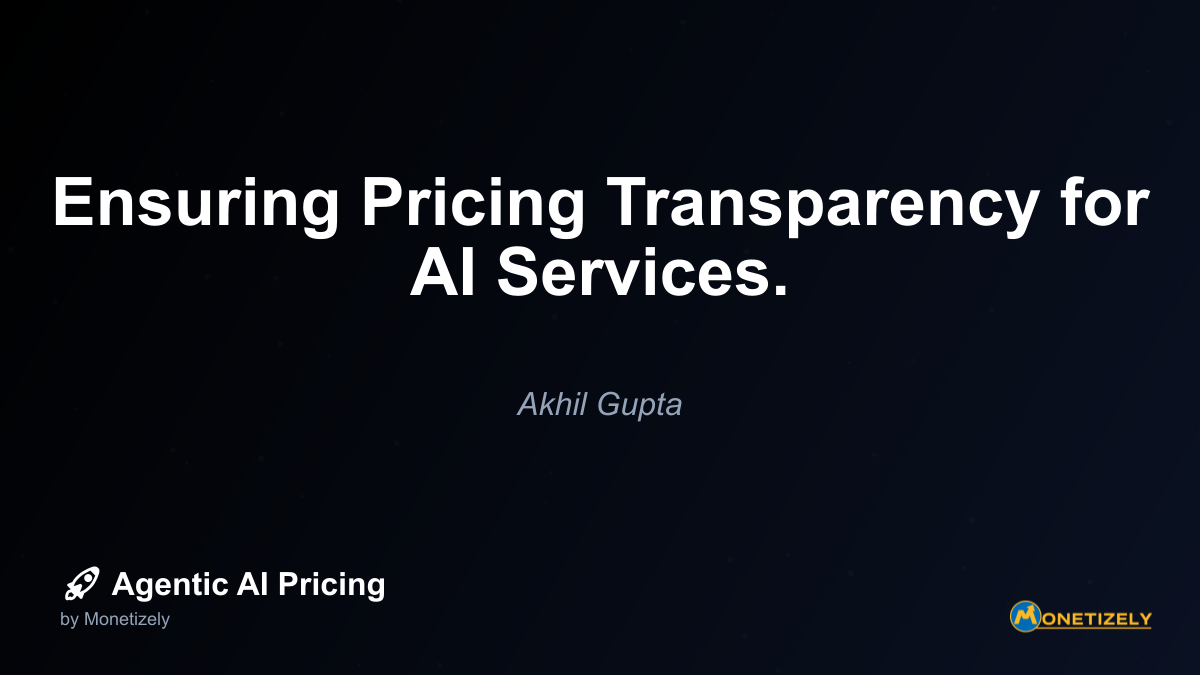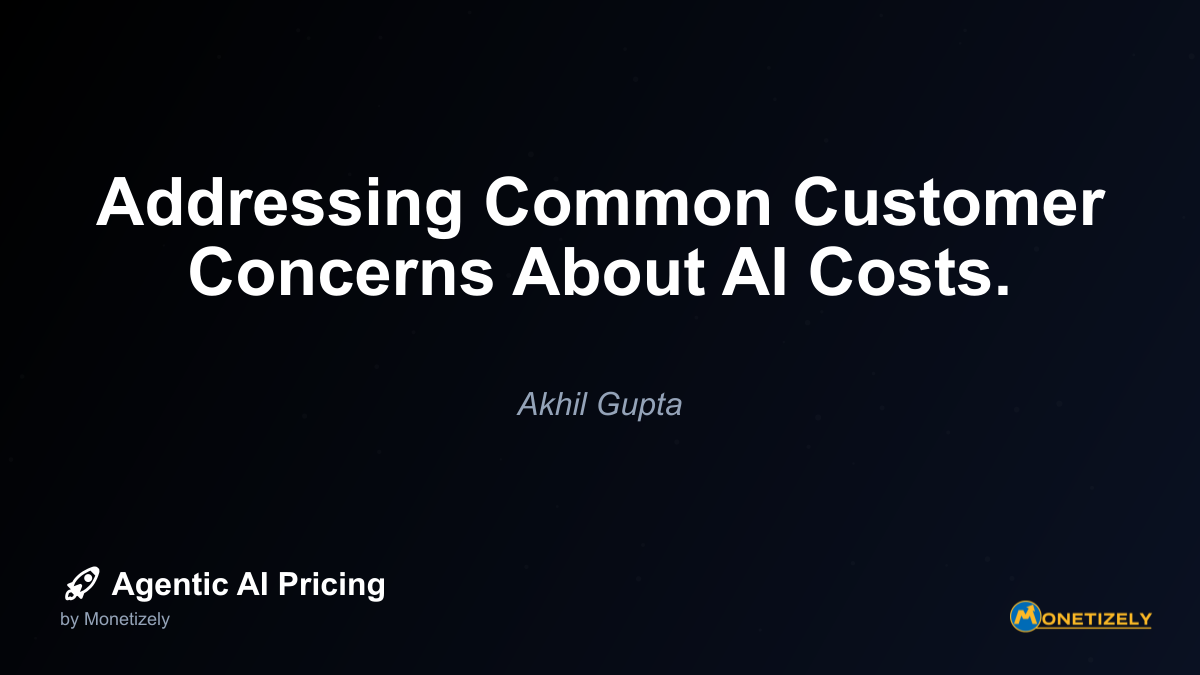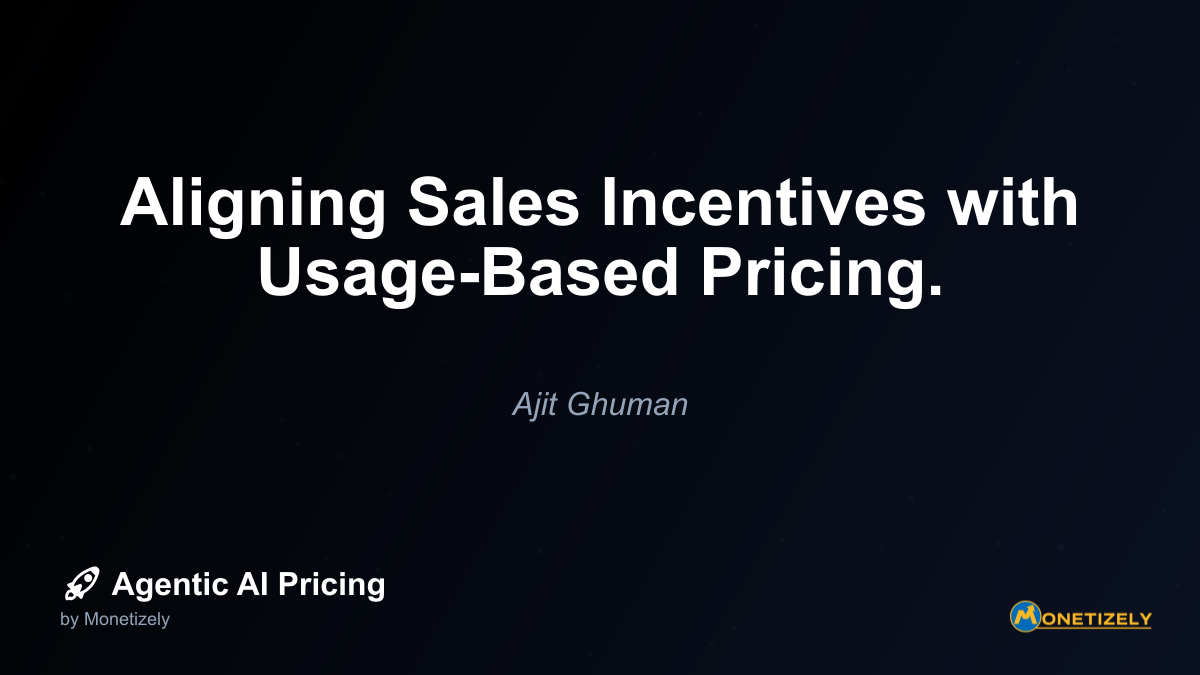· Ajit Ghuman · Best Practices · 10 min read
Building Trust with Freemium and Trial Strategies.
AI and SaaS Pricing Masterclass
Learn the art of strategic pricing directly from industry experts. Our comprehensive course provides frameworks and methodologies for optimizing your pricing strategy in the evolving AI landscape. Earn a professional certification that can be imported directly to your LinkedIn profile.

In today’s competitive AI market, building trust is essential for driving adoption and converting prospects into paying customers. Offering free tiers or trial periods has emerged as a powerful strategy for reducing friction in the customer journey, particularly for agentic AI products where value may not be immediately apparent. When implemented correctly, these strategies allow potential customers to experience tangible results before committing financially, creating a foundation of trust that drives conversions.
Why Trust Matters in Agentic AI Adoption
The adoption of agentic AI solutions faces unique challenges compared to traditional software. These autonomous systems often require users to delegate significant decision-making authority, creating inherent trust barriers. Potential customers naturally question: Will this AI agent understand my needs? Will it make appropriate decisions? Is it worth the investment?
This trust deficit is particularly pronounced in the agentic AI space for several reasons:
Outcome uncertainty: Unlike traditional software with predictable outputs, agentic AI introduces variability in results based on how it interprets and acts upon instructions.
Value demonstration challenges: The full capabilities of an AI agent often emerge over time through interaction, making it difficult to showcase complete value in a static demo.
Investment concerns: Decision-makers worry about committing resources to technology that may not deliver expected returns or might require significant adaptation periods.
Control apprehension: Many potential users fear losing control over critical business functions when delegating to AI systems.
These barriers make freemium and trial strategies particularly valuable for agentic AI providers. By allowing users to experience the technology with minimal commitment, companies can address these concerns directly through hands-on experience rather than marketing promises.
The Psychology Behind Effective Trials and Freemium Models
Successful trial and freemium strategies leverage several psychological principles that are especially relevant to agentic AI adoption:
Reciprocity
When companies offer something valuable for free, users often feel a natural obligation to reciprocate. This psychological principle can manifest as:
- Higher likelihood to provide feedback
- Increased willingness to share positive experiences
- Greater receptivity to upgrade offers
- Stronger brand loyalty even if they don’t immediately convert
For agentic AI providers, this reciprocity effect can help overcome initial skepticism and create goodwill that extends beyond the trial period.
Reduced Risk Perception
Free trials significantly lower the perceived risk of adoption. This is crucial for agentic AI products where the stakes of implementation may seem high. By removing financial commitment during the evaluation phase, companies effectively separate the risk assessment from budget concerns, allowing potential customers to focus on value and fit.
Endowment Effect
Once users begin working with an AI agent, they tend to value it more highly than before they had access. This psychological phenomenon, known as the endowment effect, creates a situation where removing the tool (at trial end) feels like a loss rather than a return to status quo. Effective trials capitalize on this by ensuring users integrate the AI into their workflows quickly, making the prospect of losing access increasingly uncomfortable as the trial progresses.
Commitment and Consistency
When users invest time in configuring and learning to work with an AI agent during a trial, they’ve made a psychological commitment to the product. This investment creates internal pressure to justify that time expenditure by continuing with the product, especially if they’ve shared positive experiences with colleagues or stakeholders.
Structuring Effective Free Tiers for Agentic AI
The design of your free tier significantly impacts both adoption rates and conversion potential. Here are key considerations for structuring free offerings that drive business growth:
Value Demonstration vs. Value Limitation
The most successful free tiers strike a delicate balance between demonstrating genuine value and creating natural limitations that incentivize upgrades. This balance typically involves:
What to include in free tiers:
- Core AI agent functionality that showcases the fundamental value proposition
- Enough capacity to solve real problems (avoiding “demo-ware” perception)
- Basic integration capabilities with common tools in your target users’ stack
- Sufficient usage limits to allow meaningful evaluation
Strategic limitations for conversion:
- Usage caps that allow evaluation but become restrictive for regular use
- Feature differentiation that reserves high-ROI capabilities for paid tiers
- Access limitations to certain types of data or advanced integrations
- Time-based restrictions that maintain functionality but prompt conversion decisions
Avoiding Common Freemium Pitfalls
Many agentic AI companies make critical mistakes when implementing freemium models:
Overly generous free tiers: When free offerings provide too much value without clear upgrade paths, users have little incentive to convert. This creates a large base of non-monetized users consuming resources.
Insufficient value demonstration: Conversely, if free tiers are too limited to showcase real capabilities, they fail to build the trust necessary for conversion decisions.
Unclear value differentiation: When the benefits of upgrading aren’t immediately apparent, users remain in free tiers even when paid features would better serve their needs.
Poor onboarding: Free users who don’t quickly understand how to derive value from the AI agent are unlikely to convert regardless of pricing structure.
To avoid these pitfalls, successful companies implement clear value ladders that guide users from free exploration to paid adoption through thoughtfully designed limitations and incentives.
Designing Effective Trial Strategies for Agentic AI
While freemium models offer perpetual access with limited functionality, trials provide full functionality for a limited time. This approach has distinct advantages for certain agentic AI products:
Trial Duration Optimization
The ideal trial length depends on your specific AI agent’s complexity and value demonstration timeline:
Shorter trials (7-14 days) work best when:
- Value can be demonstrated quickly
- The onboarding process is streamlined
- Your sales team can effectively support rapid decision-making
- The purchase price is relatively low
Longer trials (30+ days) are more appropriate when:
- Value emerges through extended use and data accumulation
- Integration with existing workflows requires significant time
- The solution involves multiple stakeholders in the decision process
- The investment level necessitates thorough evaluation
For most agentic AI solutions, the optimal trial period aligns with the time required for users to experience at least one complete value cycle—from implementation through measurable results.
Credit-Based vs. Time-Based Trials
While traditional time-based trials are common, credit-based alternatives offer unique advantages for agentic AI products:
Credit-based trials provide users with a specific allocation of AI agent usage (tasks, queries, or processing time) rather than a fixed calendar period. This approach:
- Accommodates varying exploration paces among prospects
- Prevents trial expiration before adequate evaluation
- Creates a usage-based mindset that aligns with many AI pricing models
- Provides clearer usage metrics for both customers and vendors
Many successful agentic AI providers are finding that hybrid approaches—combining time limits with usage allocations—create the most effective trial experiences by balancing evaluation flexibility with conversion urgency.
Conversion-Optimized Onboarding for Trials and Free Tiers
The onboarding experience during trials or free tier usage significantly impacts conversion rates. For agentic AI products, effective onboarding should:
Focus on Quick Wins
Design the initial user experience to deliver immediate value that demonstrates the AI agent’s capabilities. This might include:
- Pre-configured templates for common use cases
- Guided setup wizards that minimize time-to-value
- Sample data or scenarios that showcase capabilities without user input
- Automated suggestions based on initial interactions
These quick wins create positive reinforcement that motivates continued exploration and builds confidence in the solution’s value.
Implement Progressive Education
Rather than overwhelming users with comprehensive training, successful onboarding introduces capabilities progressively:
- Essential functions first: Ensure users master core interactions before introducing advanced features
- Contextual guidance: Provide tips and tutorials based on actual usage patterns
- Milestone celebrations: Acknowledge progress to reinforce learning and engagement
- Capability expansion: Gradually introduce more sophisticated features as users demonstrate readiness
This approach prevents the cognitive overload that often leads to abandonment during trials.
Leverage Usage Data for Personalized Conversion Paths
Effective trial programs collect and analyze usage data to customize the conversion approach:
- Identify which features each user finds most valuable
- Recognize usage patterns that indicate conversion readiness
- Detect potential abandonment signals for proactive intervention
- Tailor upgrade messaging to highlight personally relevant benefits
This data-driven approach allows for precisely timed and contextually appropriate conversion messaging rather than generic upgrade prompts.
Pricing Psychology for Successful Conversions
The transition from free to paid requires careful attention to pricing psychology:
Anchoring and Tiered Options
Present multiple pricing tiers that use psychological anchoring to influence perception:
- Include a premium tier that makes standard options seem more reasonable
- Clearly highlight the most popular option to provide social proof
- Frame limitations in terms of what users gain rather than what they lose
- Use feature differentiation that aligns with distinct user segments
This approach helps users self-select into appropriate tiers while maximizing perceived value.
Transparent Value Metrics
Clearly articulate the connection between pricing and value metrics:
- Define how increased investment correlates with specific outcomes
- Provide ROI calculators based on trial usage patterns
- Showcase comparative results between free and paid capabilities
- Highlight the opportunity cost of remaining on limited plans
This transparency builds trust while creating rational justification for upgrades.
Measuring Success Beyond Conversion Rates
While conversion rates are the most obvious metric for trial and freemium programs, comprehensive evaluation should consider:
User Engagement Quality
Track how users interact with your AI agent during free periods:
- Feature exploration breadth
- Depth of integration with existing workflows
- Frequency and consistency of usage
- Complexity of implemented use cases
Higher-quality engagement typically correlates with stronger conversion potential and longer customer retention.
Time-to-Value Metrics
Measure how quickly users achieve meaningful results:
- First successful outcome timing
- Rate of progressive feature adoption
- Time spent in onboarding versus active usage
- Intervals between significant usage milestones
Accelerating time-to-value typically improves both conversion rates and customer satisfaction.
Expansion Indicators
Look beyond initial conversions to expansion potential:
- Multi-user adoption within organizations
- Cross-functional implementation
- Integration with additional systems
- Usage pattern diversification
These indicators help identify accounts with high lifetime value potential beyond initial conversion.
Case Studies: Successful Trust-Building Strategies
Enterprise AI Assistant Platform
A leading enterprise AI assistant platform implemented a tiered trial strategy based on organization size:
- Small organizations: 14-day full-feature trial
- Mid-market: 30-day trial with dedicated onboarding
- Enterprise: 90-day pilot with success metrics and integration support
This segmented approach resulted in:
- 34% conversion rate for small organizations
- 47% conversion for mid-market
- 62% enterprise pilot-to-contract rate
The key insight was that different organization sizes required different trust-building timelines and support levels to reach conversion decisions.
AI Document Processing Solution
An AI document processing platform shifted from a traditional 30-day trial to a hybrid model:
- 500 document processing credits (regardless of time)
- Minimum 14-day access even if credits were used quickly
- Maximum 45-day access regardless of credit usage
This approach increased conversions by 28% while providing clearer usage metrics that helped customers select appropriate pricing tiers post-trial.
Implementing Effective Trial and Freemium Programs
To maximize the effectiveness of your trust-building strategies:
Create Clear Conversion Pathways
Design your free offerings with specific conversion triggers:
- Usage thresholds that naturally lead to paid features
- Value demonstrations that create demand for expanded capabilities
- Educational sequences that culminate in upgrade opportunities
- Integration points that encourage deeper implementation
These pathways should feel like natural progression rather than arbitrary limitations.
Develop a Nurturing Communication Strategy
Support trial and freemium users with targeted communications:
- Usage milestone celebrations
- Feature highlight sequences based on individual behavior
- Case studies relevant to observed usage patterns
- Personalized recommendations for maximizing value
This nurturing approach builds relationship and trust throughout the evaluation period.
Implement Friction-Free Upgrade Processes
Remove barriers to conversion by simplifying the upgrade process:
- One-click upgrade options at relevant moments
- Transparent pricing with no hidden costs
- Seamless transition without data or setting loss
- Flexible payment options appropriate to customer segments
Each friction point eliminated improves conversion probability.
Conclusion: Building Trust as a Competitive Advantage
In the rapidly evolving agentic AI market, building trust isn’t just about conversion tactics—it’s a fundamental competitive advantage. Well-designed trial and freemium strategies create opportunities for potential customers to experience value directly, bypassing skepticism through hands-on experience.
The most successful implementations share common characteristics:
- They provide genuine value in free offerings while creating natural upgrade incentives
- They focus on accelerating time-to-value through thoughtful onboarding
- They use data to personalize both the product experience and conversion approach
- They measure success across multiple dimensions beyond simple conversion rates
As the agentic AI market matures, companies that excel at building trust through these strategies will likely capture disproportionate market share by reducing adoption barriers and creating conversion pathways based on demonstrated value rather than marketing promises.
By implementing the principles outlined in this article, agentic AI providers can transform free offerings from cost centers into powerful trust-building assets that drive sustainable business growth while genuinely helping customers evaluate solutions that match their needs.
Co-Founder & CEO
Ajit is the author of Price To Scale, a top book on SaaS Pricing and is the Founder of Monetizely. Ajit has led and worked in pricing and product marketing at firms like Twilio, Narvar and Medallia. His work has been featured in Forbes and VentureBeat. Ajit regularly consults with software companies from Seed stage to post-IPO on pricing strategy. Ajit is also a highly-rated co-instructor for 'The Art of SaaS Pricing and Monetization' on Maven.
Pricing Strategy Audit
Let our experts analyze your current pricing strategy and identify opportunities for improvement. Our data-driven assessment will help you unlock untapped revenue potential and optimize your AI pricing approach.




